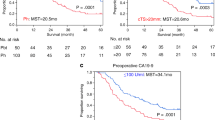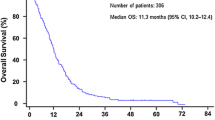Abstract
Objectives
To evaluate the prognostic value of fibrosis for patients with pancreatic adenocarcinoma (PDAC) and preoperatively predict fibrosis using clinicoradiological features. Tumor fibrosis plays an important role in the chemoresistance of PDAC. However, the prognostic value of tumor fibrosis remains contradiction and accurate prediction of tumor fibrosis is required.
Methods
The study included 131 patients with PDAC who underwent first-line surgery. The prognostic value of fibrosis and rounded cutoff fibrosis points for median overall survival (OS) and disease-free survival (DFS) were determined using Cox regression and receiver operating characteristic (ROC) analyses. Then the whole cohort was randomly divided into training (n = 88) and validation (n = 43) sets. Binary logistic regression analysis was performed to select independent risk factors for fibrosis in the training set, and a nomogram was constructed. Nomogram performance was assessed using a calibration curve and decision curve analysis (DCA).
Results
Hazard ratios of fibrosis for OS and DFS were 1.121 (95% confidence interval [CI]: 1.082–1.161) and 1.110 (95% CI: 1.067–1.155). ROC analysis identified 40% as the rounded cutoff fibrosis point for median OS and DFS. Tumor diameter, carbohydrate antigen 19-9 level, and peripancreatic tumor infiltration were independent risk factors; areas under the nomogram curve were 0.810 and 0.804 in the training and validation sets, respectively. The calibration curve indicated good agreement of the nomogram, and DCA demonstrated good clinical usefulness.
Conclusions
Tumor fibrosis was associated with poor OS and DFS in patients with PDAC. The nomogram incorporating clinicoradiological features was useful for preoperatively predicting tumor fibrosis.
Key Points
• Tumor fibrosis is correlated with poor prognosis in patients with pancreatic adenocarcinoma.
• Tumor fibrosis can be categorized according to its association with overall survival and disease-free survival.
• A nomogram incorporating carbohydrate antigen 19-9 level, tumor diameter, and peripancreatic tumor infiltration is useful for preoperatively predicting tumor fibrosis.





Similar content being viewed by others
Abbreviations
- AUC:
-
Area under the curve
- CI:
-
Confidence interval
- CPA:
-
Collagen proportional area
- DCA:
-
Decision curve analysis
- DFS:
-
Disease-free survival
- ICC:
-
Interclass correlation coefficient
- OS:
-
Overall survival
- PDAC:
-
Pancreatic ductal adenocarcinoma
- PTI:
-
Peripancreatic tumor infiltration
- ROC:
-
Receiver operating characteristic
- TA:
-
CT attenuation values at pancreatic phase of tumor
- TN:
-
CT attenuation values at non-enhanced phase of tumor
- TV:
-
CT attenuation values at portal vein phase of tumor
References
Feig C, Gopinathan A, Neesse A, Chan DS, Cook N, Tuveson DA (2012) The pancreas cancer microenvironment. Clin Cancer Res 18:4266–4276
Olive KP, Jacobetz MA, Davidson CJ et al (2009) Inhibition of Hedgehog signaling enhances delivery of chemotherapy in a mouse model of pancreatic cancer. Science 324:1457–1461
Hallmann R, Zhang X, Di Russo J et al (2015) The regulation of immune cell trafficking by the extracellular matrix. Curr Opin Cell Biol 36:54–61
Hwang RF, Moore T, Arumugam T et al (2008) Cancer-associated stromal fibroblasts promote pancreatic tumor progression. Cancer Res 68:918–926
Jacobetz MA, Chan DS, Neesse A et al (2013) Hyaluronan impairs vascular function and drug delivery in a mouse model of pancreatic cancer. Gut 62:112–120
Khan S, Ebeling MC, Chauhan N et al (2015) Ormeloxifene suppresses desmoplasia and enhances sensitivity of gemcitabine in pancreatic cancer. Cancer Res 75:2292–2304
Alvarez R, Musteanu M, Garcia-Garcia E et al (2013) Stromal disrupting effects of nab-paclitaxel in pancreatic cancer. Brit J Cancer 109:926–933
Suenaga M, Yamada S, Fujii T et al (2016) S-1 plus nab-paclitaxel is a promising regimen for pancreatic cancer in a preclinical model. J Surg Oncol 113:413–419
Shi S, Liang C, Xu J et al (2020) The strain ratio as obtained by endoscopic ultrasonography elastography correlates with the stroma proportion and the prognosis of local pancreatic cancer. Ann Surg 271:559–565
Erstad DJ, Sojoodi M, Taylor MS et al (2020) Fibrotic response to neoadjuvant therapy predicts survival in pancreatic cancer and is measurable with collagen-targeted molecular MRI. Clin Cancer Res 26:5007–5018
Klaassen R, Steins A, Gurney-Champion OJ et al (2020) Pathological validation and prognostic potential of quantitative MRI in the characterization of pancreas cancer: preliminary experience. Mol Oncol 14:2176–2189
Wang LM, Silva MA, D'Costa Z et al (2016) The prognostic role of desmoplastic stroma in pancreatic ductal adenocarcinoma. Oncotarget 7:4183–4194
Wegner CS, Gaustad JV, Andersen LM, Simonsen TG, Rofstad EK (2016) Diffusion-weighted and dynamic contrast-enhanced MRI of pancreatic adenocarcinoma xenografts: associations with tumor differentiation and collagen content. J Transl Med 14:161
Hashimoto Y, Sclabas GM, Takahashi N et al (2011) Dual-phase computed tomography for assessment of pancreatic fibrosis and anastomotic failure risk following pancreatoduodenectomy. J Gastrointest Surg 15:2193–2204
Sinha A, Singh VK, Cruise M et al (2015) Abdominal CT predictors of fibrosis in patients with chronic pancreatitis undergoing surgery. Eur Radiol 25:1339–1346
Cai X, Gao F, Qi Y et al (2020) Pancreatic adenocarcinoma: quantitative CT features are correlated with fibrous stromal fraction and help predict outcome after resection. Eur Radiol 30:5158–5169
Al-Hawary MM, Francis IR, Chari ST et al (2014) Pancreatic ductal adenocarcinoma radiology reporting template: consensus statement of the society of abdominal radiology and the American Pancreatic Association. Gastroenterology 146:291–304.e291
Shi Y, Liu Y, Gao F et al (2018) Pancreatic stiffness quantified with MR elastography: relationship to postoperative pancreatic fistula after pancreaticoenteric anastomosis. Radiology 288:476–484
Park HJ, Kim HJ, Kim KW et al (2020) Comparison between neuroendocrine carcinomas and well-differentiated neuroendocrine tumors of the pancreas using dynamic enhanced CT. Eur Radiol 30:4772–4782
Tirkes T, Shah ZK, Takahashi N et al (2019) Reporting standards for chronic pancreatitis by using CT, MRI, and MR cholangiopancreatography: The Consortium for the Study of Chronic Pancreatitis, Diabetes, and Pancreatic Cancer. Radiology 290:207–215
Kim DW, Lee SS, Kim SO et al (2020) Estimating recurrence after upfront surgery in patients with resectable pancreatic ductal adenocarcinoma by using pancreatic CT: development and validation of a risk score. Radiology 296:541–551
Gore J, Korc M (2014) Pancreatic cancer stroma: friend or foe? Cancer Cell 25:711–712
Thomas D, Radhakrishnan P (2019) Tumor-stromal crosstalk in pancreatic cancer and tissue fibrosis. Mol Cancer 18:14
Biffi G, Tuveson DA (2021) Diversity and biology of cancer-associated fibroblasts. Physiol Rev 101:147–176
Pereira BA, Vennin C, Papanicolaou M et al (2019) CAF subpopulations: a new reservoir of stromal targets in pancreatic cancer. Trends Cancer 5:724–741
Torphy RJ, Wang Z, True-Yasaki A et al (2018) Stromal content is correlated with tissue site, contrast retention, and survival in pancreatic adenocarcinoma. JCO Precis Oncol 2:1–12. https://doi.org/10.1200/PO.17.00121
Stopa KB, Kusiak AA, Szopa MD, Ferdek PE, Jakubowska MA (2020) Pancreatic cancer and its microenvironment-recent advances and current controversies. Int J Mol Sci 21:3218
Chiou SH, Risca VI, Wang GX et al (2017) BLIMP1 induces transient metastatic heterogeneity in pancreatic cancer. Cancer Discov 7:1184–1199
Lohse I, Lourenco C, Ibrahimov E, Pintilie M, Tsao MS, Hedley DW (2014) Assessment of hypoxia in the stroma of patient-derived pancreatic tumor xenografts. Cancers (Basel) 6:459–471
Engle DD, Tiriac H, Rivera KD et al (2019) The glycan CA19-9 promotes pancreatitis and pancreatic cancer in mice. Science 364:1156–1162
Mann DV, Edwards R, Ho S, Lau WY, Glazer G (2000) Elevated tumour marker CA19-9: clinical interpretation and influence of obstructive jaundice. Eur J Surg Oncol 26:474–479
Acknowledgements
The authors thank Zhuochen Lin for his statistical suggestions.
Funding
This study was supported in part by the National Natural Science Foundation of China (Grant Number 81771908, 81971684).
Author information
Authors and Affiliations
Corresponding authors
Ethics declarations
Guarantor
The scientific guarantor of this publication is Shi-Ting Feng from Department of Radiology, The First Affiliated Hospital, Sun Yat-sen University.
Conflict of interest
The authors of this manuscript declare no relationships with any companies, whose products or services may be related to the subject matter of the article.
Statistics and biometry
Zhuochen Lin kindly provided statistical advice for this manuscript.
Informed consent
Written informed consent was waived by the Institutional Review Board.
Ethical approval
Institutional Review Board approval was obtained.
Methodology
• retrospective
• prognostic study
• performed at one institution
Additional information
Publisher’s note
Springer Nature remains neutral with regard to jurisdictional claims in published maps and institutional affiliations.
Supplementary Information
ESM 1
(DOCX 34 kb)
Rights and permissions
About this article
Cite this article
Shi, S., Luo, Y., Wang, M. et al. Tumor fibrosis correlates with the survival of patients with pancreatic adenocarcinoma and is predictable using clinicoradiological features. Eur Radiol 32, 6314–6326 (2022). https://doi.org/10.1007/s00330-022-08745-z
Received:
Revised:
Accepted:
Published:
Issue Date:
DOI: https://doi.org/10.1007/s00330-022-08745-z




